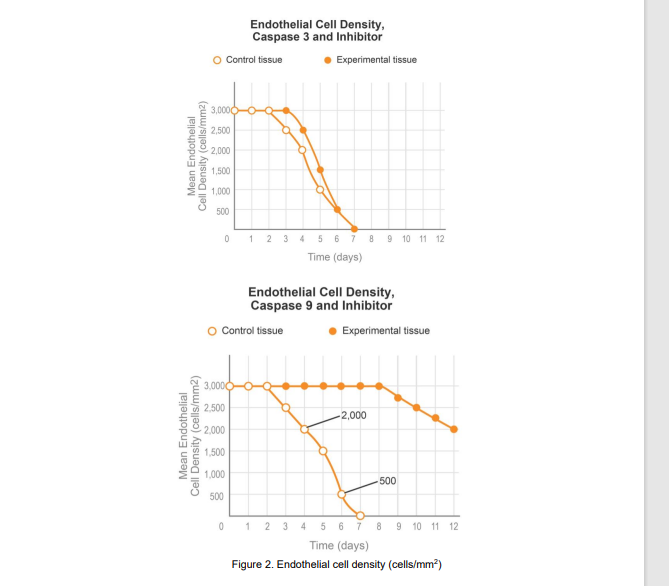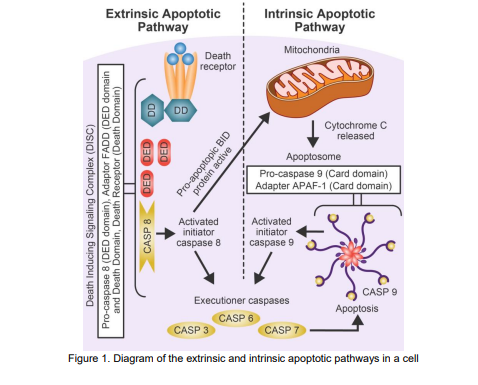Caspase proteins are enzymes known to play a role in programmed cell death (apoptosis) and the inflammatory response. Apoptotic caspases are subcategorized into initiator and executioner caspases. Initiator caspases produce a chain reaction that activates executioner caspases. Caspase 9 is a kind of initiator caspase and caspase 3 is a kind of executioner caspase that plays a direct role in degrading cellular components. Apoptosis can be activated by internal (intrinsic) cellular mechanisms or external (extrinsic) signals. The extrinsic apoptotic pathway begins with the reception of a signal at the death receptors and the intrinsic apoptotic pathway begins with the permeabilization of the mitochondria. Both apoptotic caspase pathways are shown in Figure 1. Caspase proteins have been implicated in the premature death of cornea endothelial tissue being stored for transplant. To investigate the effect of caspases 3 and 9 on tissue degradation, scientists monitored the endothelial cell density of cornea tissue, left isolated from other tissues, over a period of seven days. Scientists then exposed cornea endothelial tissue to caspase 3 and caspase 9 inhibitors and monitored the endothelial tissue cell density over a period of 12 days (Figure 2).
Caspase proteins are enzymes known to play a role in programmed cell death (apoptosis) and
the inflammatory response. Apoptotic caspases are subcategorized into initiator and executioner
caspases. Initiator caspases produce a chain reaction that activates executioner caspases.
Caspase 9 is a kind of initiator caspase and caspase 3 is a kind of executioner caspase that plays
a direct role in degrading cellular components.
Apoptosis can be activated by internal (intrinsic) cellular mechanisms or external (extrinsic)
signals. The extrinsic apoptotic pathway begins with the reception of a signal at the death
receptors and the intrinsic apoptotic pathway begins with the permeabilization of the
mitochondria. Both apoptotic caspase pathways are shown in Figure 1.
Caspase proteins have been implicated in the premature death of cornea endothelial tissue being
stored for transplant. To investigate the effect of caspases 3 and 9 on tissue degradation,
scientists monitored the endothelial cell density of cornea tissue, left isolated from other tissues,
over a period of seven days. Scientists then exposed cornea endothelial tissue to caspase 3 and
caspase 9 inhibitors and monitored the endothelial tissue cell density over a period of 12 days
(Figure 2).


Trending now
This is a popular solution!
Step by step
Solved in 2 steps


